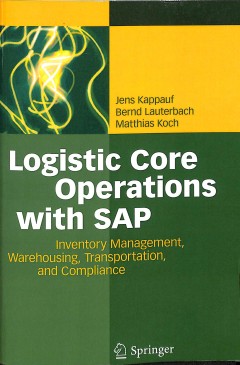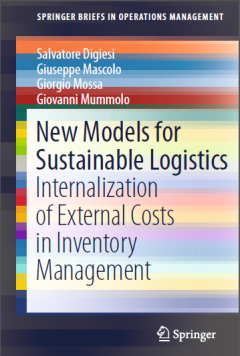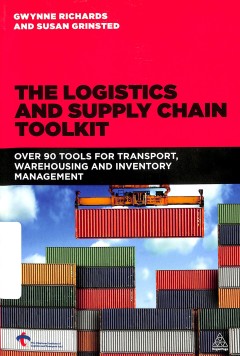Ditapis dengan

Logistic core operations with SAP : inventory management, warehousing, transp…
Logistic Core Operations with SAP” not only provides an overview of core logistics processes and functionality—it also shows how SAP’s Business Suite covers logistic core operations, what features are supported, and which systems can be used to implement end-to-end processes in the following logistic core disciplines: Procurement, Distribution, Transportation, Warehouse Logistics and Inve…
- Edisi
- -
- ISBN/ISSN
- 978-3-642-43593-5
- Deskripsi Fisik
- viii, 293 p., ; illus : 21 cm ; index
- Judul Seri
- -
- No. Panggil
- TXT LO KAP l

New models for sustainable logistics: internalization of external costs in in…
- Edisi
- -
- ISBN/ISSN
- 978-3-319-19710-4
- Deskripsi Fisik
- -
- Judul Seri
- -
- No. Panggil
- TXT LO DIG n
- Edisi
- -
- ISBN/ISSN
- 978-3-319-19710-4
- Deskripsi Fisik
- -
- Judul Seri
- -
- No. Panggil
- TXT LO DIG n

A nonlinear multi objective approach for the supplier selection, integrating …
The impact of transportation on the supplier selection has received very scant attention in the literature. This is a great limitation because splitting orders across multiple suppliers will lead to smaller transportation quantities which will likely imply larger transportation cost. Moreover, transportation and inventory elements are highly interrelated and contribute most to the total logisti…
- Edisi
- Vol. 2 No. 2, 2007
- ISBN/ISSN
- -
- Deskripsi Fisik
- 15 p.
- Judul Seri
- Journal of Modelling in Management
- No. Panggil
- ATC LO LAD a

The logistics and supply chain toolkit : over 90 tools for transport, warehou…
- Edisi
- -
- ISBN/ISSN
- 978-0-74946808
- Deskripsi Fisik
- xi, 313 p, 22 cm
- Judul Seri
- -
- No. Panggil
- TXT LO RIC t
- Edisi
- -
- ISBN/ISSN
- 978-0-74946808
- Deskripsi Fisik
- xi, 313 p, 22 cm
- Judul Seri
- -
- No. Panggil
- TXT LO RIC t

A model for designing multiple products logistics networks
This study aims to provide a model for designing logistics networks with multiple products. In such a design model, it is important to determine the operation-related parameters accurately.
- Edisi
- Vol. 36 No. 2, 2006 pp. 127-135
- ISBN/ISSN
- 0960-0035
- Deskripsi Fisik
- 11 p.
- Judul Seri
- International Journal of Physical Distribution & Logistics Management
- No. Panggil
- ATC LO MAH a

Inventory management support systems for emergency humanitarian relief operat…
To develop and test three different inventory management strategies as applied to the complex emergency in south Sudan.
- Edisi
- Vol. 17 No. 2, 2006 pp. 187-212
- ISBN/ISSN
- -
- Deskripsi Fisik
- 31 p.
- Judul Seri
- The International Journal of Logistics Management
- No. Panggil
- ATC LO KOT i

Near-optimal heuristics and managerial insights for the storage constrained, …
The purpose of this paper is to develop efficient heuristics for determining the route design and inventory management of inbound parts which are delivered for manufacturing, assembly, or distribution operations and for which there is limited storage space. The shipment frequencies and quantities are coordinated with the available storage space and the vehicle capacities.
- Edisi
- Vol. 42 No. 2, 2012 pp. 152-173
- ISBN/ISSN
- -
- Deskripsi Fisik
- 24 p.
- Judul Seri
- International Journal of Physical Distribution & Logistics Management
- No. Panggil
- ATC LO SOX n

Aligning distribution center operations to supply chain strategy
A major focus of modern day logistics is on achieving a higher level of responsiveness to marketplace demand, but with less inventory. Achieving the dual targets of lower cost and higher service has implications for every stage in the supply chain and in particular for distribution center operations. What is the extent to which organizations are adjusting their distribution center operations to…
- Edisi
- Vol. 15 Issue: 1, pp.111-123
- ISBN/ISSN
- -
- Deskripsi Fisik
- 15 p.
- Judul Seri
- The International Journal of Logistics Management
- No. Panggil
- ATC LO BAK a

A content analysis of research approaches in logistics research
Based on a framework developed by Kova´cs and Spens, this paper seeks to assess the use of the three different research approaches in logistics research; discuss the use of different research methods within the three research approaches; find and discuss applications of the abductive research approach to logistics problems
- Edisi
- Vol. 36 No. 5, 2006
- ISBN/ISSN
- -
- Deskripsi Fisik
- 22 p.
- Judul Seri
- International Journal of Physical Distribution & Logistics Management
- No. Panggil
- ATC LO SPE a

A Review of Inventory Management Research in Major Logistics Journals: Themes…
Purpose – The purpose of this paper is to provide a review of inventory management articles published in major logistics outlets, identify themes from the literature and provide future direction for inventory management research to be published in logistics journals. Design/methodology/approach – Articles published in major logistics articles, beginning in 1976, which contribute to the …
- Edisi
- Vol. 19 Iss 2 pp
- ISBN/ISSN
- 0957-4093
- Deskripsi Fisik
- 24 p
- Judul Seri
- The International Journal of Logistics Management
- No. Panggil
- ATC LO WIL a

Multi-Product Maritime Inventory Routing With Optional Cargoes : An Applicati…
Purpose – The ocean transportation of automobiles is carried out by specialized Roll-on/Roll-off ships, which are designed to carry a large number of automobiles at a time. Many of these shipping companies have vertically integrated or collaborated with other logistics services providers to offer integrated maritime logistics solution to car manufacturers. The purpose of this study is to d…
- Edisi
- Vol. 10 Iss 2
- ISBN/ISSN
- 0972-7981
- Deskripsi Fisik
- 26 p
- Judul Seri
- Journal of Advances in Management Research
- No. Panggil
- ATC MR CHA m

Multi-Product Maritime Inventory Routing With Optional Cargoes : An Applicati…
Purpose – The ocean transportation of automobiles is carried out by specialized Roll-on/Roll-off ships, which are designed to carry a large number of automobiles at a time. Many of these shipping companies have vertically integrated or collaborated with other logistics services providers to offer integrated maritime logistics solution to car manufacturers. The purpose of this study is to d…
- Edisi
- Vol. 10 Iss 2 pp
- ISBN/ISSN
- 0972-7981
- Deskripsi Fisik
- 26 p
- Judul Seri
- Journal of Advances in Management Research
- No. Panggil
- ATC MR CHA m

The supply chain balancing act - stock and service at a profit
Addresses the perennial issues of effective supply‐chain management ‐ balancing stock inventories, service delivery mechanisms and retaining requisite profit margins while ensuring customer loyalty ‐ against the background of increasing business competition in the 1990s. Considers the potential contributions of partnerships, inventory management, sales‐based ordering and promotion pla…
- Edisi
- Vol. 9 Issue: 6, pp.24-26
- ISBN/ISSN
- -
- Deskripsi Fisik
- 5 p.
- Judul Seri
- Logistics Information Management
- No. Panggil
- ATC LO BLA t

Optimizing inventory and store results in big box retail environment
This paper seeks to examine key factors within the control of store managers to optimizing inventory and store results.
- Edisi
- Vol. 36 No. 3, 2008 pp. 180-191
- ISBN/ISSN
- -
- Deskripsi Fisik
- 14 p.
- Judul Seri
- International Journal of Retail & Distribution Management
- No. Panggil
- ATC LO AYA o

Just- in- time : some effects on the logistics function
This article provides an analysis of inbound logistics incorporated in a JIT manufacturing environment. An inventory‐theoretic model is presented that measures the implications of JIT manufacturing on the logistics process and the ability of inbound consolidation opportunities to accommodate these implications. Key components of the inventory‐theoretic model are indentified and the sensit…
- Edisi
- Vol. 1 Issue: 2, pp.25-34
- ISBN/ISSN
- -
- Deskripsi Fisik
- 12 p.
- Judul Seri
- The International Journal of Logistics Management
- No. Panggil
- ATC LO BUF j

Inventory holding costs measurement: a multi-case study
Logisticians in the worldwide industry are frequently faced with the problem of measuring the total cost of holding inventories with simple and easy-to-use methodologies. The purpose of this paper is to look at the problem, and in particular illustrate the inventory holding cost rate computation, when different kind of warehousing systems are applied.
- Edisi
- Vol. 25 No. 1, 2014 pp. 109-132
- ISBN/ISSN
- -
- Deskripsi Fisik
- 26 p.
- Judul Seri
- The International Journal of Logistics Management
- No. Panggil
- ATC LO SGA i

Healthcare supply chain management in Malaysia: a case study
The purpose of this paper is to evaluate inventory management in the private healthcare sector in Malaysia, with a particular focus on the distribution of medicines from a wholesaler to clinics. Currently, there are issues with service levels to clinics that need addressing.
- Edisi
- Volume 14 · Number 3 · 2009 · 234–243
- ISBN/ISSN
- -
- Deskripsi Fisik
- 12 p.
- Judul Seri
- Supply Chain Management: An International Journal
- No. Panggil
- ATC LO POT h

Framework for characterizing the design of VMI systems
The purpose of this study is to provide for the research community as well as for the practitioners measures that enable the evaluation, categorization and comparison of vendor managed inventory (VMI) systems .
- Edisi
- Vol. 37 No. 10, 2007 pp. 782-798
- ISBN/ISSN
- -
- Deskripsi Fisik
- 20 p.
- Judul Seri
- International Journal of Physical Distribution & Logistics Management
- No. Panggil
- ATC LO STA f

Floating stocks in FMCG supply chains: using intermodal transport to facilita…
The purpose of this paper is to consider the use of temporary storage offered by intermodal transshipment points to position some stock of fast moving consumer goods in advance of demand; this floating stock concept combines transport and inventory management. Intermodal transport is compared with direct road transport for a supply chain.
- Edisi
- Vol. 39 No. 8, 2009 pp. 632-648
- ISBN/ISSN
- -
- Deskripsi Fisik
- 19 p.
- Judul Seri
- International Journal of Physical Distribution & Logistics Manag
- No. Panggil
- ATC LO DEK f

Floating stocks in FMCG supply chains: using intermodal transport to facilita…
The purpose of this paper is to consider the use of temporary storage offered by intermodal transshipment points to position some stock of fast moving consumer goods in advance of demand; this floating stock concept combines transport and inventory management. Intermodal transport is compared with direct road transport for a supply chain.
- Edisi
- Vol. 39 No. 8, 2009 pp. 632-648
- ISBN/ISSN
- -
- Deskripsi Fisik
- 19 p.
- Judul Seri
- International Journal of Physical Distribution & Logistics Management
- No. Panggil
- ATC LO KUS f

Exploring the benefits of vendor managed inventory
The purpose of this paper is to explore the performance increase achieved by vendor managed inventory (VMI) under different levels of outside supply capacity, demand uncertainty, and lead time.
- Edisi
- Vol. 37 No. 7, 2007 pp. 529-545
- ISBN/ISSN
- -
- Deskripsi Fisik
- 20 p.
- Judul Seri
- International Journal of Physical Distribution & Logistics Management
- No. Panggil
- ATC LO SAR e

Effective sourcing strategies for perishable product supply chains
The purpose of this paper is to assess whether an existing sourcing strategy can effectively supply products of appropriate quality with acceptable levels of product waste if applied to an international perishable product supply chain. The authors also analyse whether the effectiveness of this sourcing strategy can be improved by including costs for expected shelf life losses while generating o…
- Edisi
- Vol. 44 No. 6, 2014 pp. 494-510
- ISBN/ISSN
- -
- Deskripsi Fisik
- 19 p.
- Judul Seri
- International Journal of Physical Distribution & Logistics Management
- No. Panggil
- ATC LO VAN e

Demand categorisation in a European spare parts logistics network
Spare parts have become ubiquitous in modern societies and managing their requirements is an important and challenging task with tremendous cost implications for the organisations that are holding relevant inventories. An important operational issue involved in the management of spare parts is that of categorising the relevant stock keeping units (SKUs) in order to facilitate decision-making wi…
- Edisi
- Vol. 29 No. 3, 2009 pp. 292-316
- ISBN/ISSN
- -
- Deskripsi Fisik
- 28 p .
- Judul Seri
- International Journal of Operations & Production Management
- No. Panggil
- ATC LO BAB d

Coping with the challenges of indirect sales and distribution controlling in …
The purpose of this article is to analyze problems involved in using a four-tiered, indirect sales-and-distribution (S&D) model and describe how a manufacturing small and medium-sized enterprise’s (SME’s) controller can master them.
- Edisi
- Vol. 39 No. 12, 2011 pp. 927-944
- ISBN/ISSN
- -
- Deskripsi Fisik
- 20 p.
- Judul Seri
- International Journal of Retail & Distribution Management
- No. Panggil
- ATC LO RIT c

Coordinating a supply chain with a heterogeneous vehicle fleet under greenhou…
This paper studies a supply chain consisting of multiple suppliers and a single buyer. It considers the case where a set of heterogeneous trucks is used for transporting products, and develops a mathematical model that coordinates the supply chain. The purpose of this paper is to minimise the costs of producing and delivering a product as well as carbon emissions resulting from transportation. …
- Edisi
- Vol. 26 No. 3, 2015 pp. 494-516
- ISBN/ISSN
- -
- Deskripsi Fisik
- 25 p.
- Judul Seri
- The International Journal of Logistics Management
- No. Panggil
- ATC LO KIM c

Consumer-driven retail operations: The moderating effects of consumer demand …
The purpose of this paper is to investigate the direct and interaction effects of shelf space, case pack quantity, and consumer demand on shelf stockouts, i.e. stockouts at the shelf level when inventory is available in the backroom of a retail store.
- Edisi
- Vol. 41 No. 5, 2011 pp. 420-434
- ISBN/ISSN
- -
- Deskripsi Fisik
- 17 p.
- Judul Seri
- International Journal of Physical Distribution & Logistics Management
- No. Panggil
- ATC LO ERO c

An approach to improving logistical performance with cross-unit benchmarking
The paper aims to help identify the best logistical practices and to implement them with minimal organizational resistance in an environment with relatively similar business units utilizing an internal benchmarking approach.
- Edisi
- Vol. 15 No. 5, 2008 pp. 618-629
- ISBN/ISSN
- -
- Deskripsi Fisik
- 14 p.
- Judul Seri
- Benchmarking: An International Journal
- No. Panggil
- ATC LO HUI a

A reverse logistics inventory model for plastic bottles
The purpose of this paper is to present an original model for the production-recyclingreuse of plastic beverage bottles.
- Edisi
- Vol. 25 No. 2, 2014 pp. 315-333
- ISBN/ISSN
- -
- Deskripsi Fisik
- 21 p .
- Judul Seri
- The International Journal of Logistics Management
- No. Panggil
- ATC LO SEA a
 Karya Umum
Karya Umum  Filsafat
Filsafat  Agama
Agama  Ilmu-ilmu Sosial
Ilmu-ilmu Sosial  Bahasa
Bahasa  Ilmu-ilmu Murni
Ilmu-ilmu Murni  Ilmu-ilmu Terapan
Ilmu-ilmu Terapan  Kesenian, Hiburan, dan Olahraga
Kesenian, Hiburan, dan Olahraga  Kesusastraan
Kesusastraan  Geografi dan Sejarah
Geografi dan Sejarah